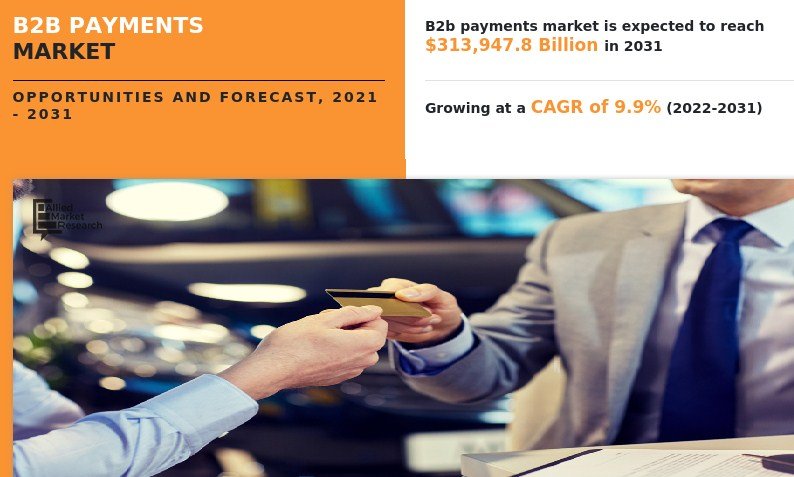The global business-to-business (B2B) payments market is expected to witness a significant growth in the next decade, according to a new report by Allied Market Research. The report, titled “B2B Payments Market by Payment Type, Enterprise Size, Payment Method, Industry Vertical: Global Opportunity Analysis and Industry Forecast, 2021-2031”, estimates that the market size will reach $313.9 billion by 2031, growing at a compound annual growth rate (CAGR) of 9.9% from 2021 to 2031.
What are B2B Payments and Why are They Important?
B2B payments are transactions between two business entities for goods and services that are delivered through the supply chain process. B2B payments can be domestic or cross-border, and can involve various payment methods such as bank transfers, cards, e-wallets, and others.
B2B payments are important for several reasons. First, they enable efficient and secure trade between businesses across different industries and regions. Second, they facilitate cash flow management and working capital optimization for both buyers and sellers. Third, they provide data and insights that can help businesses improve their operations, customer relationships, and profitability.
What are the Key Drivers and Challenges of the B2B Payments Market?
The B2B payments market is driven by several factors, such as:
- Rapid digitalization and automation of the B2B payment solutions, which offer faster, safer, and more convenient payment options for businesses.
- Growth of global trade and e-commerce, which increase the demand for cross-border and online B2B payments.
- Rise of fintech innovations and partnerships, which introduce new products and services that cater to the specific needs and preferences of different B2B segments.
- Increasing adoption of cloud-based and blockchain-based platforms, which enable more transparent, traceable, and cost-effective B2B payments.
However, the B2B payments market also faces some challenges, such as:
- High processing costs and fees associated with traditional payment methods, especially for cross-border transactions.
- Payment delays and inefficiencies caused by manual and paper-based processes, lack of standardization, and regulatory complexities.
- Fraud risk and security concerns due to the increasing sophistication of cyberattacks and the lack of adequate authentication and encryption measures.
- Resistance to change and low awareness among some businesses about the benefits and opportunities of digital B2B payments.
What are the Key Segments and Regions of the B2B Payments Market?
The B2B payments market can be segmented by payment type, enterprise size, payment method, industry vertical, and region.
By payment type, the market can be divided into domestic payments and cross-border payments. Domestic payments refer to transactions within the same country or region, while cross-border payments refer to transactions across different countries or regions. Cross-border payments are expected to grow faster than domestic payments during the forecast period, due to the increasing globalization of businesses and the emergence of new payment corridors.
By enterprise size, the market can be classified into large enterprises, medium-sized enterprises, and small-sized enterprises. Large enterprises are those with annual revenues above $1 billion, medium-sized enterprises are those with annual revenues between $50 million and $1 billion, and small-sized enterprises are those with annual revenues below $50 million. Small-sized enterprises are projected to grow faster than large and medium-sized enterprises during the forecast period, due to their higher adoption rate of digital payment solutions.
By payment method, the market can be categorized into bank transfer, cards, e-wallets, and others. Bank transfer is the most widely used payment method in the B2B payments market, as it offers reliability, security, and familiarity for businesses. Cards are the second most popular payment method in the market, as they offer convenience, speed, and rewards for businesses. E-wallets are the fastest growing payment method in the market, as they offer low-cost, mobile-friendly, and flexible payment options for businesses.
By industry vertical, the market can be segmented into manufacturing, IT and telecom, metals and mining, energy and utilities, banking, financial services, and insurance (BFSI), government sector, and others. Manufacturing is the largest industry vertical in the B2B payments market, as it involves a complex supply chain network that requires efficient and secure payment solutions. IT and telecom is the second largest industry vertical in the market, as it involves a high volume of cross-border and online transactions that require fast and convenient payment solutions.
By region, the market can be divided into North America, Europe, Asia-Pacific, and LAMEA (Latin America, Middle East, and Africa). North America is the dominant region in the B2B payments market, as it has a mature and advanced payment infrastructure that supports various types of B2B transactions. Asia-Pacific is the fastest growing region in the market, as it has a large and growing number of small and medium-sized enterprises that are adopting digital payment solutions.
What are the Key Players and Strategies in the B2B Payments Market?
The B2B payments market is highly competitive and fragmented, with the presence of various players that offer different products and services for different B2B segments. Some of the key players in the market are:
- American Express Company
- Ant Group Co., Ltd.
- Fiserv, Inc.
- Fleetcor Technologies, Inc.
- Intuit Inc.
- JPMorgan Chase & Co.
- Mastercard Incorporated
- PayPal Holdings, Inc.
- Stripe, Inc.
- Visa Inc.
Some of the key strategies adopted by these players are:
- Expanding their product portfolio and service offerings to cater to the diverse and evolving needs and preferences of different B2B segments.
- Developing and launching new and innovative payment solutions that leverage emerging technologies such as artificial intelligence, machine learning, cloud computing, and blockchain.
- Forming strategic partnerships and alliances with other players in the payment ecosystem, such as banks, fintech companies, payment networks, and software providers, to enhance their capabilities and reach.
- Acquiring and investing in other players in the market to gain access to new markets, customers, technologies, and expertise.

